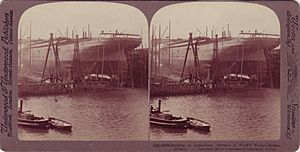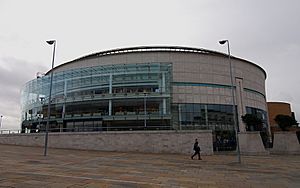Economy of Belfast facts for kids
The economy of Belfast, Northern Ireland started with trade through its harbour. Later, big industries like shipbuilding and linen making helped it grow a lot. At the start of the 1900s, Belfast was the world's top producer of linen. It also had the biggest shipyard in the world.
For many years, civil unrest affected the city's industries. But after peace agreements in the mid-1990s, like the Good Friday Agreement and the St Andrews Agreement in 2006, Belfast's economy has started to grow strong again.
How Belfast's Economy Grew
When Belfast's population grew in the 1600s, its economy was all about trade. It was a market for the nearby countryside. The natural inlet of Belfast Lough gave the city its own port. This port allowed trade with Great Britain, and later with Europe and North America.
In the mid-1600s, Belfast sent out goods like beef, butter, animal hides, and corn. It brought in coal, cloth, wine, and tobacco. Around this time, the linen trade in Northern Ireland became very successful. By the mid-1700s, one-fifth of all linen exported from Ireland left from Belfast.
The city we see today really grew during the Industrial Revolution. When new ways of working changed the linen and shipbuilding industries, Belfast's economy and population boomed. By the early 1800s, Belfast was the world's largest linen-making centre. This earned the city the nickname "Linenopolis" during the Victorian Era and into the early 1900s.
About 100,000 people in Belfast, mostly women, worked in the linen trade by the 1900s. However, shipbuilding became the main industry from the 1870s onwards.
Belfast harbour was made deeper in 1845 for bigger ships. Donegall Quay was built further into the river as the harbour grew. Trade became very busy. The Harland & Wolff shipbuilding company started in 1861. By the time the Titanic was built in Belfast in 1912, they had the biggest shipyard in the world.
After World War I, people started buying more mass-produced and cotton clothes. This was one reason why Belfast's international linen trade began to shrink. Like many UK cities that relied on heavy industries, Belfast faced a big decline from the 1960s. This got much worse in the 1970s and 1980s because of the civil unrest. Over 100,000 factory jobs were lost since the 1970s. For many years, Northern Ireland's economy needed a lot of financial help from the British government.
Belfast's Economy Today
Peace agreements in the 1990s, like the 1994 ceasefire and the Good Friday Agreement in 1998, made investors feel safer about putting money into Belfast. This led to a time of steady economic growth. Many parts of the city centre were rebuilt.
New projects included Victoria Square, the Cathedral Quarter, and the Laganside area. This area got the new Odyssey complex and the Waterfront Hall.
Two other big projects were the Titanic Quarter redevelopment and the building of the Obel Tower. In 2007, Belfast planned to create a World Trade Centre. This aims to help promote the city to businesses around the world.
As of 2017, Belfast is Northern Ireland's main centre for education and business. In 2007, it was one of the top five fastest-growing regional economies in the UK. In February 2006, Belfast's unemployment rate was 4.2%. This was lower than both the Northern Ireland and UK averages. Over 10 years, jobs in Belfast grew by 16.4%, which is much more than the UK average of 9.2%.
The period of peace has also caused property prices in the city to rise a lot. In 2006, house prices in Belfast grew by 43%. This was the fastest growth rate in the UK. In March 2007, the average house in Belfast cost about £191,819. In South Belfast, the average was about £241,000.
Peace has also brought more tourists to Belfast. There were 6.4 million visitors in 2005, which was an 8.5% increase from 2004. These visitors spent about £285.2 million. This supported over 15,600 jobs. The city's two airports have also made Belfast a popular weekend travel spot in Europe.
Large wind turbine parts for the Burbo Bank Offshore Wind Farm extension are put together in Belfast.
Due to the COVID-19 pandemic, Belfast's economy has faced some challenges, according to PricewaterhouseCoopers.



